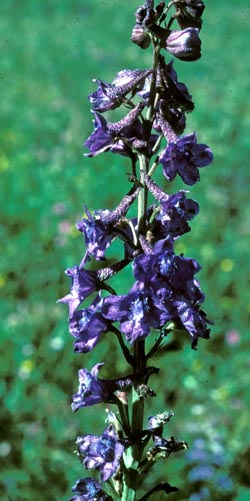Tall Larkspur

Common Name(s):
Tall Larkspur
Duncecap Larkspur
Western Larkspur
Scientific Name:
Delphinium occidentale (S. Wats.) S. Wats.
Scientific Name Synonyms:
None Known
Symbol:
DEOC
Description:
Life Span: Perennial
Origin: Native
Season: Warm
Growth Characteristics: An erect forb growing 3 to 8 feet tall, with stems that are somewhat straw-colored and hollow at the base and a darker bluish color above. It grows from a deep, vertical, woody taproot, beginning growth in late spring, flowering July to August, and seeds maturing from August to September. Reproduces from seeds.
Flowers/Inflorescence: Perfect and irregular. Bluish-purple in color with a spur-like projection on the calyx, which looks like a duncecap, hence its name. Flowers grow in dense clusters (raceme) at the top of the stem.
Fruits/Seeds: Fruits are follicles, which are highly poisonous.
Leaves: Divided into sharp pointed segments (palmately lobed), hairy, and resemble geranium in pre-bloom stage.
Ecological Adaptions:
Tall larkspur occurs in meadows, thickets, stream banks, around springs and in moist meadows and open woods. It is most abundant where the snow pack persists. It is usually associated with aspen and spruce groves.
Soils: Favors deep, loamy, well-developed soils.
Associated Species: Aspen, goldenrod, Richardson's geranium, chokecherry, brome grasses.
Uses and Management:
Tall larkspur provides fair to good forage for sheep and some wildlife. It is palatable to cattle even though other plants are available. Horses seldom eat it. Tall larkspur is poisonous to cattle until after blossoming. It contains alkaloids, which act on the nervous system. Death may result following paralysis of breathing; bloat is common. Seeds are the most poisonous part of the plant.
American Indians crushed Larkspur plants and applied it to their hair to control lice and other insects.

